The following are extracts from the text Distance Divides Radio Unites – History of the Charleville School of the Air and Charleville School of Distance Education 1966 – 1996 by Karen Riethmuller.

The Australian Experience
Copies of this informative and reflective book are available for purchase from the school. Please contact reception.
“Australia is a large and geographically diverse and challenging country. Early pioneers and settlers were not daunted by distances, and the settlement of inland Australia proceeded, despite the tyranny of distance. The educational needs of isolated and homebound children were met by the establishment of correspondence departments by the various educational authorities. Lessons were sent by mail to remote students as long ago as 1916.”
“Any students who were not serviced by local schools were eligible to receive lessons by correspondence. . . Lessons were usually dispatched to the pupils on a fortnightly basis by the city based correspondence teacher. The student, in turn, completed the papers with assistance of a supervisor or home tutor (eg. mother, older sibling or employed governess) and returned the papers to the Correspondence School for correction and subsequent feedback on progress.”

“Miss Adelaide Meithke was an outstanding educationalist who had been awarded an Order of the British Empire in 1937, for her contribution to education. She was an executive officer of the Australian Aerial Medical Service, which later became the Royal Flying Doctor Service. Miss Meithke wished to do more to alleviate the silence, muteness and lonely vigil of the outback child. Whilst visiting outback homesteads in Central Australia, she observed that Traeger transceiver radios in most homes for medical purposes. Why not use these radios for educational purposes? Why not give these remote students some ‘classmates’?”
“1949 saw the inception and birth of lessons using HF radio and the Royal Flying Doctor Service network. In the beginning, there were only three lessons a week, delivered by Miss Meithke. . . As a result, the first official School of the Air was opened on June 8, 1951 at Alice Springs.”
The Queensland Experience
“Queensland possessed a vast outback, and rural Queensland families wished to share in the School of the Air experience, which was successfully operating in other Australian states. In Queensland, the dreamers who made this vision a reality were Dr Allan Vickers (Medical Supervisor of the Royal Flying Doctor Service – Queensland), the Hon. J. C. A. Pizzey, M.L.A. and Minister for Education, and Mr A. E. Guymer, Director of Primary Education. Cloncurry was home of the Royal Flying Doctor Service in North West Queensland in 1960 and on the 25th January, 1960, the first School of the Air lesson was broadcast to Queensland pupils. Fourteen students from the Croydon, Winton, Julia Creek, Camooweal, Normanton and Birdsville areas called in to the inaugural lesson.”
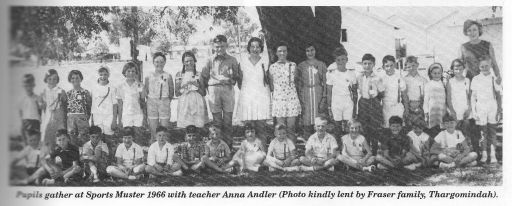
Charleville School of the Air
“The Charleville School of the Air came into existence in 1966, with the first lessons being broadcast on the 24th January of that year. The school was opened to benefit the children of rural and isolated families who were linked to the Charleville Royal Flying Doctor Service by the normal transceiver system. The first broadcast was made by a teacher who had been granted a small section of the verandah at the Royal Flying Doctor Service base in King Street, which was furnished with an office table, swivel chair, a cupboard and a transceiver. This was the studio, and indeed, the entire school.”
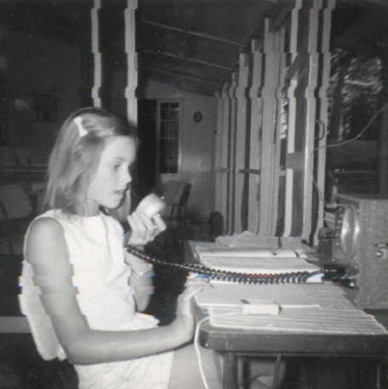
“In April of 1965, Dr Allan Vickers and Mr Archibald E. Guymer met with the primary aim of considering the possibility of providing a School of the Air at Charleville for the 1965 academic year. The Royal Flying Doctor Service expressed its willingness and readiness to co-operate in the establishment of a School of the Air, and was prepared to make 2-3 hours available each school day for broadcasts.”
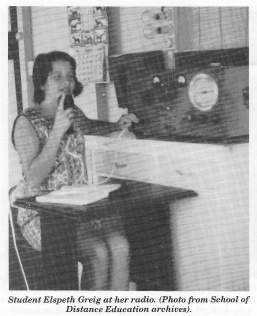
“The Director General of Education sent a letter to all families on the 14th January, 1966, advising that School of the Air lessons would commence on 24th January. . . Miss Anna Andler was the first teacher, and conducted the very first lesson. The times for the broadcasts were to be 10.30 – 11.00, 1.00 – 2.00 and 3.00 – 3.30, as had been negotiated . . .There were some 44 children who called in during the first weeks.”
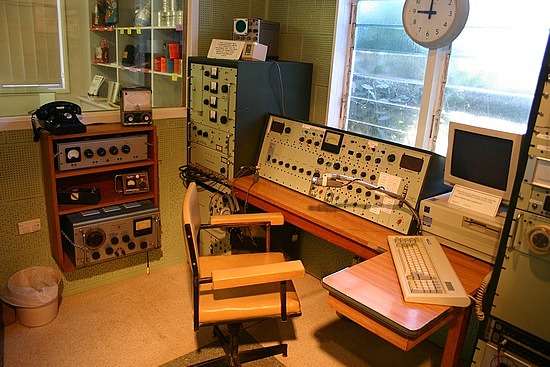
“In 1966, Anna Andler, whilst having dinner with Mr and Mrs Peter Ford (a Charleville dentist), commented that she would like to meet her pupils. Mr Peter Ford suggested that the School of the Air should have a Sports Day. In subsequent co-operation with Anna Andler, a program for a Sports Day ‘Muster’ was drawn up, with the intention of gathering children and parents so they could meet class mates and fellow home supervisors. Of the 21 families who were ‘on air’, 20 were able to attend the inaugural Muster on Saturday, 15th October, 1966.”
1970
“It was official – Charleville School of the Air was the largest in the world. It consisted of four teachers and ran lessons for 11 hours ‘on air’ each day. Lessons were conducted for more than 200 children residing in an area of 250 square miles.”

1976
“A new venture for 1976 was the publication of ‘Kalora’ the first school magazine for Charleville School of the Air. The title and cover design were chosen from ideas sent in by pupils. The name ‘Kalora’ means ‘message stick’ in Aboriginal, and the title was suggested by Dianne Letchford.”
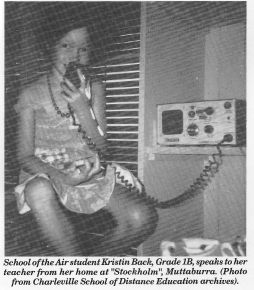
1977
“The primary staffing inspector recommended that a transportable modular building be placed in the School of the Air grounds. . . The building provided a preparation area, staffroom and storerooms.”
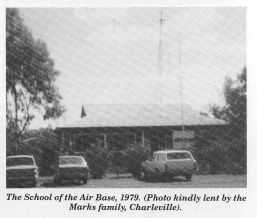
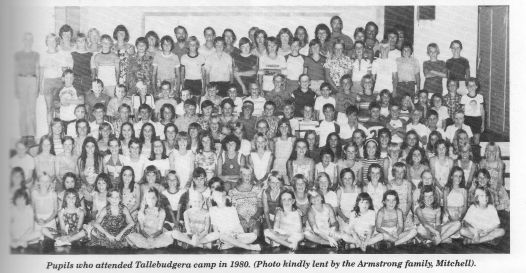
1985
“In early 1985, it was predicted in the local western Queensland media that School of the Air could disappear, due to the planned $1 million satellite trial. If the planned video-computer link was successful, the fate of School of the Air bases such as Charleville was unknown, said the report.”
1987
“The school continued to improve. A second telephone line was put into the school to cope with the increased use of lines in and out of the school. The Parents’ and Citizens’ Association donated an Apple computer. . . The Parents’ and Citizens’ of the School of the Air continued to object to the possible proposed name change from School of the Air to School of Distance Education. The grounds of objection were based on the additional expense that would be incurred in changing uniforms, school badges, school flags, stationery, souvenirs etc. Additional cost would also be involved in designing a new logo and badge, and concerns were also expressed with losing the historical interest that associated with the name ‘School of the Air'.

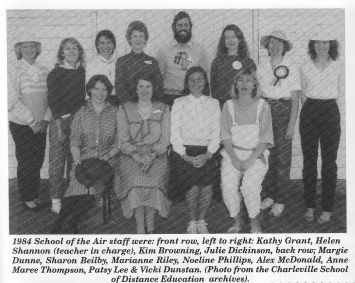
1988
“The deconcentralised Distance Education Centre that would be built in Charleville would be based on the concept of a single school, where all distance education services would be co-ordinated from the one base. The centre would also recognise the fact that the location of such services should be such that it facilitated the best possible mode of delivery to the students. A centralised support unit would be established to provide for co-ordination and equality of services through the state. This unit would be responsible for the development of core learning materials and a range of other support services.
In July, 1988, The Principal Education Officer for Distance Education in Queensland, Mr Ian Wallace visited Charleville to outline plans to upgrade the School of the Air to a Distance Education Centre... The name Distance Education would replace names like correspondence lessons, School of the Air, telephone teaching, etc. . . Mr Noel Christie, senior officer from the Education Department informed that the building would be incorporated into the grounds of Charleville State High School. . . Another consideration (in making a new building) was the fact that the telephone communications, computer use and electronic mail systems would be subject to interference from the HF radio transmission system.”
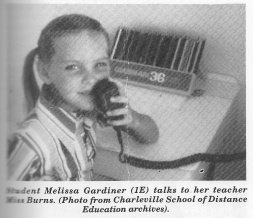
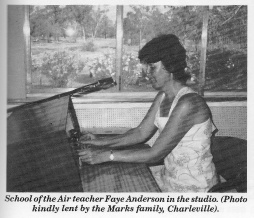
1989
“In early 1989, the name was officially changed from ‘Charleville School of the Air’ to ‘School of Distance Education – Charleville Centre’. Parents expressed concerns tha the name change had occurred before the new building was erected. Others voiced their disappointment over the lack of prior discussion in regard to the name change, and others at not retaining a name that is unique to Australia and easily recognisable. As a consequence the name was changed to ‘School of Distance Education – Charleville Centre (incorporating School of the Air established 1966)’.”
1990
“The new School of Distance Education logo was designed, and it retained and incorporated the Royal Flying Doctor Service and School of the Air insignias. . . Disaster struck Charleville town on 20 April, 1990. The worst flood to hit south west Queensland in more than a century had invaded Charleville. A state of emergency was declared after a record eight metre flood peak was reached in the Warrego River. Over 2200 people were displaced from their homes and businesses as the floodwaters rose and peaked. Once the floodwaters receded, the clean-up began.
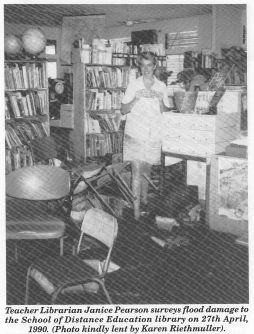
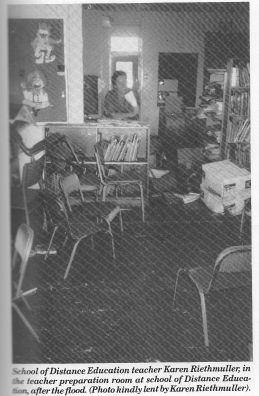
The School of Distance Education did not escape the ravages of the flood, and had to cancel lessons for the first time in 24 years. The flood was to deal a severe blow to the fledging School of Distance Education. The broadcast studios and transmission facilities were submerged, and out of action. The Library at the base, and the curriculum learning materials that were stored at the State Primary School, were all totally enshrouded in water and mud. Many of the staff lost all that they owned, including teaching resources. The postal and telephone systems were out of action. On 1st August, work commenced on constructing the new Distance Education building.”
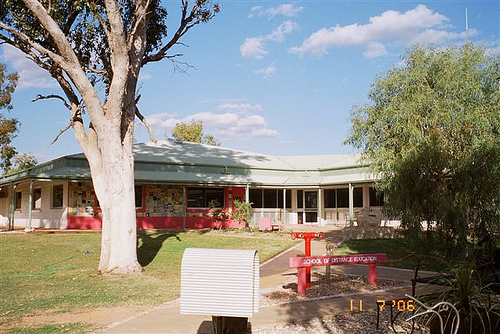
1991
“In early April, the new building was completed to the stage where staff were able to move in. . . However, teachers still had to travel daily to the old base to deliver on-air lessons, as the studios had not been completed in the new building. The four new consoles were commissioned and tested on Friday, 12th July. . . Transmission quality could be enhanced with the use of satellites, which would ensure there would always be a clear voice signal, and this would replace the out of date two-way radios.”
1995
“June 30, 1995 also saw the formal cessation of links between the School of Distance Education and the Royal Flying Doctor Service in regard to the provision of technical services to the school. The School of Distance Education was to employ a technical officer in early 1996, who would be based at the school, and would carry out the general maintenance on studios and HF studios.”
(The following has been written by Karen Reithmuller as an addition to the extracts from her book).
1996
The school celebrated thirty years of operations. More than 620 people attended the anniversary celebrations in June. The weekend featured a roll call of past and present students and teachers; the launch of a book which documented the 30 year history of the school, and the presentation of a quilt made by the students to the Royal Flying Doctor Service in recognition of their services provided to the school in the last 30 years.
HF radio was the key communication medium used to deliver on air lessons and additional frequencies were granted for use by the school, in order to improve on air flexibility. This meant the school now had access to 8 SDE owned frequencies and 2 RFDS frequencies. The first technical officer was employed at the school, and a workshop area was set up, and a new state of the art HF transmitter was commissioned.
In 1996, a trial commenced where modems were being used in schoolrooms. A Year 5 class had been issued with modems and were completing assignment work on the home computer, and then emailing this to the teacher. The trial was reasonably successful, with challenges centering on software and telephone line infrastructure. The majority of families within the school did not have computers in the home. The Computers In the Home project utilised Apple computers, which were loaned to the families.
The Student Council was a proactive forum in the school, and led the way in starting a Landcare Club for students. The students also raised fund to purchase computer software, videos and sports equipment.
Sports Muster saw more than 200 students travel to Charleville. A highlight was a visit from the television program “Totally Wild” crew, who filmed extensively at the muster. Students enjoyed line dancing, viewing the Queensland Museums Travelling Exhibition as well as the traditional track and field events.
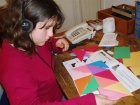
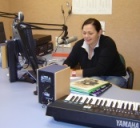
1997
Year 6 and 7 students commenced a trial that utilised telephones for enhancing HF radio lessons. HF radio was the key medium, however when reception was poor, students were encouraged to dial into the HF lesson using the phone system. Due to various technical difficulties, these blended lessons were not a huge success.
1998
This year, our school was launched as a “Leading School”, where we became ‘simply the best’. This was a school based management initiative that aimed to enhance the operations of the school. A School Council was established as part of this initiative.
The telephone trial continued this year, with some Year 6 and 7 students being involved. These same students were also involved in the Computer in Homes project. A part time technology officer was also employed by the school, to assist students with their computer use. Students in Years 6 and 7 who had an internet connection were able to email one assignment each fortnight to their teacher.
The school held its first technology muster, where students and home tutors attended in-services where they upskilled their technology abilities, and collected a school owned computer that would be lent to them for the year.
Physical Education and Music specialist teachers were also introduced, with the students receiving on air lessons in these areas on a regular basis. These teachers also travelled to field events throughout the year, to offer hands on experiences in these key learning areas.

1999
The school established its own website, and was one of the very few schools in rural Qld to have a website. The website was updated three times each week with notices, so that families could remain up to date with various happenings in the school. The Year 6 – 9 teachers were also putting various lessons on the website for students to use in conjunction with their on air lessons. After the lesson, students were then able to email their work to the class teacher.
A communication and leadership club was established in the school. This club aimed to given students and parents public speaking skills, and was very popular.
2000
The year 2000 saw the school community lobbying hard for the permanent continuation of telephone teaching. The Parent’s and Citizen’s meeting was held by phone for the first time in May. Guest speakers from outside our HF radio area, and speakers who did not have access to HF radio were now able to join members for meetings, and provide input.
A new school uniform was introduced for students. The shirt was a polo knit design with a contrasting collar with the school name or sporting house printed onto the collar.
2001
Permanent approval was received this year to utilise telephone teaching as a permanent student teacher interaction tool. With a joyous ‘over and out’, the HF system was decommissioned, and a new era of voice clarity, interactivity and enhanced learning was embedded. The school also wished to add to the magic of the telephone lessons, and trialled Net Meeting as a synchronous learning tool. The exploration of technologies continued.
2002
By 2002, 89% of families had email facilities, and 99% of families had telephone access to the schools audio bridge. When used in combination, this meant our school now had instant, fast and reliable communication to assist with enhancing teaching and learning. Electronic feedback sheets to home tutors and students were now being used extensively.
The Curriculum store was relocated from far flung buildings on the campus to a remodelled area near the main SDE building. This made for further efficiencies in managing resources and staff communication. The mailroom was also relocated to an area within the main SDE building.
Teaching and learning initiatives continued to grow, with the hosting of our first ever interstate Year 6 – 1-0 Camp, and the provision of TAFE provided rural vocational education in the form of hands on learning in wool handling at the ‘Woolshed”.
The school had for many years provided a string instrument musical program for students. However 2002 saw the introduction of woodwind instruments, which was enthusiastically taken up by students. The school choir also performed at a Federal ICPA conference that was held in Charleville. What made this performance different was that no choir members actually attended conference, however they all sang via the telephone at their remote home locations, along with students from The Southport School who were gathered at their school. The students were accompanied by an isolated SDE student playing a didgeridoo from his property near Injune, and the choir teacher conducting the choir from her studio in Charleville. Upon completion of the choir item, students were able to hear the warm applause of the hundreds of conference attendees, by phone.
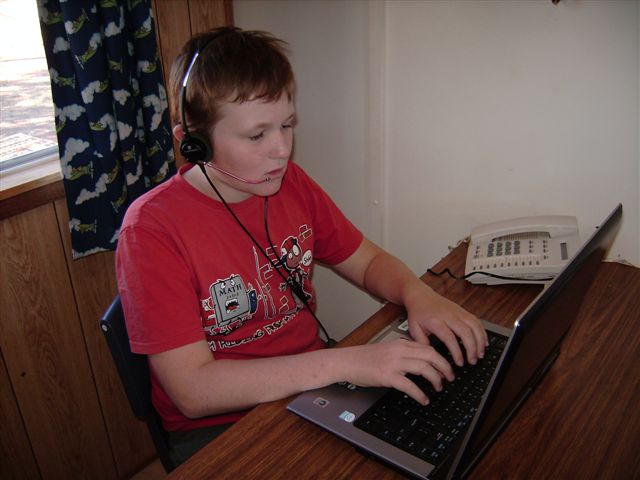
2003
This year saw the continuation of implementing innovative ICT initiatives. The digitisation of work to be returned to the class teacher was a huge step forward for all year levels. Occurring concurrently with this were large amounts of time devoted to ICT training for staff, parents/home tutors and students.
The Middle Years of schooling became ain important initiative that aimed to recognise the importance of getting the middle years of schooling right for students. Some significant personal achievements were recorded for a number of Year 7 – 1- students as a result of this initiative.
The School was accepted to trial the Prep year of schooling in 2004, as part of the ‘Outback Hub’, in conjunction with Longreach and Mount Isa SDE’s.
The school continued to make enhancements to literacy and numeracy on air class grouping. By working with the curriculum and in-servicing staff about a variety of pedagogies, teachers were able to focus on improving student learning in these core areas.
2004
This year saw the introduction of a Prep Year class, and we had four students and one teacher trialling this innovative new educational initiative. The remainder of the students in the class came from Mt Isa and Longreach Schools’ Of Distance Education.
Middle Phase of Learning reforms continued to be implemented to enhance our curriculum offerings to students in Years 4-9. School Building Committees were established to investigate and plan for the building of a multi-functional classroom, and to source funding for this building.
Career and Vocational Educational initiatives have continued, and our school trialled the use of Student Education and Training Plans (SETP’s) this year. This was a planning process that assisted students in Year 10 to determine future work/study/life directions.
In 2004, 52% of students were submitting work e.g. projects, independent writing utilising technology. 100% of families had a computer in the home, with 91% of families having an internet connection, and 18% of students used digitised materials regularly. ICT musters continued to be held, and students and home tutors gathered to learn about notebook computers, video editing software, digital cameras, animation software and voice editing.
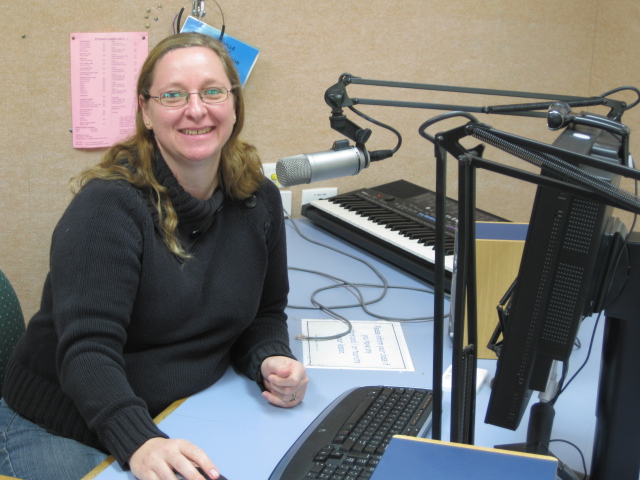
2005
2005 saw the school initiated trial of Interactive Distance Learning using high speed internet connection for Year 1 – 7. This trial proved to be popular with both staff and students alike, with lots of innovative learning occurring using this medium. Four SDE teachers participated in an ICT innovations trial, and used digital cameras, electronic portfolios and curriculum integration to benefit students. A multi media centre was established at SDE, which contained all the school owned key ICT equipment in one easy to access and secure room.
Various Middle Phase of Learning initiatives were continued, including an enhanced Pastoral Care Program for Years 8 – 10, and expanded vocational training options. A range of literacy enhancements were also implemented, under a school based program titled “Raising the Bar”. Prep – Year 10 students benefited, and continued to progress their literacy learning.
An exceptional field event program continued to be offered to students at 11 different regional centres throughout the year, and fantastic participation levels were reported. On Air lessons benefited from upgrades to the schools telebridge, as well as a program to replace telephones/headsets with new and enhanced telephones/headsets that had a range of benefits that would benefit students learning.
The Parent’s and Citizen’s Association and the school continued to work together to plan for a ‘meeting space’ building, and funding applications were submitted. The P&C also purchased webcams, microphones and digital cameras for use by students at field events and at home.
For the first time, a musical keyboarding club was offered as an extra-curricular activity, and this was very popular with students.
The Garden and Cultural Precinct area was planted and established in a large area of scalded ground in front of the main SDE building. This area included a dry creek bed feature, ornamental bridges crossing the creek, metal sculptures, additional car parking spaces, over 100 trees and shrubs and the installation of an automatic watering system. At Sports Muster, families and staff were invited to purchase a tree, and plant them in the cultural and garden precinct.
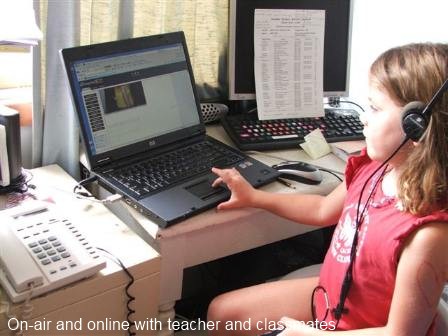
2006
The Charleville School of Distance Education celebrated its 40th anniversary this year, and over 600 people attended the various events (Dinner and Awards, Race Meeting and informal morning tea) that made up the weekend. Highlights of the event included the Alf Traeger oration to honour the inventor of the pedal radio, the presentation of Mulga Awards to key Western Qld groups and individuals, a race meeting, a morning tea that included markets, displays, stalls and a hot air balloon. A unique feature that was opened during this event was the Friendship Pathway, which lined the footpath that lead from the cultural and garden precinct area to the main entrance of the school.
The integration of ICT’s into the curriculum continued to be a key feature at our school. 95% of families had a computer, and 84% had a connected computer. 81% of the families had a 256k or better connection speed. The Learning Place’s Blackboard data conferencing facility was used to enhance student/teacher interaction.
The 2006 Literacy Strategy focused on writing, with staff and home tutors being in serviced on effective writing strategies. As a result of individual phone reading lessons for students, the continuation of THRASS, the prioritising of independent writing and the supplementary reader program, literacy outcomes were improved.
2007
In 2007, each class had a regularly updated electronic Blackboard site for student and home tutor use. These electronic elearning sites allowed for a variety of rich asynchronous learning. Teachers were also able to use a smart board, which featured a touch sensitive surface at field events, as well as having a large fixed board in the ICT room at the SDE base. On air lessons continued to utilise traditional telephone teaching, supported by a variety of synchronous electronic learning tools.
This year saw the completion of an indoor – outdoor learning area between A and B Blocks. This area was used as a small group and 1-1 meeting area for staff, parents and students.
The Queensland Curriculum, Assessment and Reporting initiative continued to be actively progressed in the school. New look report cards were used for the first time, and curriculum modifications continued with the distance education learning materials. Extra-curricular clubs offered this year included Japanese, THRASSIT, Keyboarding, reading, violin, recorder, guitar and ICT.
The Parent’s and Citizens Association continued to be to support the school, and celebrated its 40th anniversary at Sports Muster.

2008 onwards – moving from paper to digital
Since 2008, the school’s curriculum materials have been progressively transferred from paper-based print to digital formats. Units of work in English, Mathematics, Science, Humanities, Technologies, Health and Physical Education, Languages and the Arts became available on memory stick or CD and online as part of the school’s eLearn courses. This shift to digital delivery allowed students and home tutors to access up-to-date materials quickly and submit work electronically between home and school.
Mid-2010s – Australian Curriculum and expanding programs
By the mid-2010s, Charleville School of Distance Education was delivering the Australian Curriculum from Prep to Year 10 across a geographical catchment of more than 400,000 square kilometres. Teachers conducted daily telephone and web-conferencing lessons for primary and secondary students, supported by a comprehensive field-event program including Minischools, a Year 4–10 camp and the annual Sports Muster. Swim Musters and other field events continued to play an important role in building connection, confidence and school spirit for students who lived great distances from each other.
Home tutors were supported through a dedicated Kick Start Conference held in February, along with ongoing liaison and information sessions. Extra-curricular activities such as recorder, keyboard, guitar, Japanese, technology and reading clubs gave students further opportunities to explore interests beyond the core curriculum.
2016 – 50 years of Charleville distance education
In 2016 the school community celebrated 50 years since the first School of the Air broadcasts commenced from Charleville in 1966. Past and present students, families and staff gathered for a weekend of anniversary events that recognised the pioneering work of the early School of the Air teachers and home tutors, the ongoing importance of Sports Muster, camps and swim musters, and the ways in which technology had transformed distance education over half a century while the challenges of isolation remained.
Today – “Divided by distance, united by voice”
Today, Charleville School of Distance Education continues to live its motto “Divided by distance, united by voice”. The school offers distance education programs from Prep to Year 10, supported by caring and committed staff, individualised curriculum pathways and an extensive calendar of field events such as Minischools, Whole School Muster Week, Sports Muster, Swim Muster and camps.
Digital technologies – including online units, web-conferencing, QLearn and access to e-books and online library catalogues – are used alongside strong partnerships with home tutors and rural communities to provide quality education for geographically isolated students. While the methods of delivery have evolved from HF radios to telephones and sophisticated online platforms, the school’s core purpose remains the same: to ensure that children living in rural and remote Queensland can learn, connect and thrive.